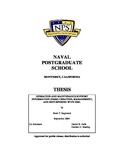Operation and Maintenance Support Information (OMSI) creation, management, and repurposing with XML
| dc.contributor.advisor | Dolk, Daniel R. | |
| dc.contributor.advisor | Bradley, Gordon H. | |
| dc.contributor.author | Raymond, Scott P. | |
| dc.date.accessioned | 2012-03-14T17:31:25Z | |
| dc.date.available | 2012-03-14T17:31:25Z | |
| dc.date.issued | 2004-09 | |
| dc.identifier.uri | https://hdl.handle.net/10945/1355 | |
| dc.description.abstract | New facility construction and existing facility renovation create new or modified operation and maintenance (O&M) requirements for the maintenance responsibility organization such as a Public Works Department (PWD). This O&M requirement is fully described by an Operation and Maintenance Support Information (OMSI) package. OMSI content includes facility, systems, and product information. This thesis will address information integration, the process of allowing information systems to cross-communicate and share data. OMSI information integrated within the framework of a Computer-Aided Facility Management (CAFM) system allows for early identification of O&M requirements, an improved planning capability for new facilities, and more efficient economies of scale. In addition to PWD manpower savings, OMSI-CAFM integration will also allow a revolution in the way O&M requirements are planned and created. Preliminary OMSI information would be ideally created by the design A/E after having considered work force capability from both a workload and expertise perspective. While this may be impractical due to the changing nature of workforce capability and the lengthy planning and design cycle of military construction, OMSI-CAFM integration will certainly allow O&M planning to begin early in the OMSI development stages. OMSI submittals can be layered to provide preliminary planning information in the first submittal and add additional detailed information in later submittals. In such a manner, PWD O&M planners can begin an incremental planning effort early in the facility construction phase. This thesis provides a non-proprietary, no-cost solution to OMSI-CAFM information integration that minimizes specialized knowledge on the part of the OMSI AE. This will allow a broad applicability of the solution to all OMSI developers, including those for smaller non-MILCON projects that aren’t specifically funded for OMSI generation. An effective solution must also provide for easy and inexpensive repurposing of OMSI information for future (and as yet unknown) uses. The solution uses XML technologies (XML, XSD, XLS, XLST, XPath, XQuery, etc) and XML storage systems for the content creation, management, and repurposing of OMSI information. | en_US |
| dc.description.uri | http://archive.org/details/operationndmaint109451355 | |
| dc.format.extent | xiv, 123 p. : ill. (some col.) ; | en_US |
| dc.publisher | Monterey California. Naval Postgraduate School | en_US |
| dc.rights | This publication is a work of the U.S. Government as defined in Title 17, United States Code, Section 101. Copyright protection is not available for this work in the United States. | en_US |
| dc.subject.lcsh | Information storage and retrieval systems | en_US |
| dc.subject.lcsh | XML (Document markup language) | en_US |
| dc.title | Operation and Maintenance Support Information (OMSI) creation, management, and repurposing with XML | en_US |
| dc.type | Thesis | en_US |
| dc.contributor.corporate | Naval Postgraduate School (U.S.). | |
| dc.contributor.department | Information Systems Technology | |
| dc.description.service | Lieutenant Commander, Unites States Navy | en_US |
| etd.thesisdegree.name | M.S. in Information Technology Management | en_US |
| etd.thesisdegree.level | Masters | en_US |
| etd.thesisdegree.discipline | Information Technology Management | en_US |
| etd.thesisdegree.grantor | Naval Postgraduate School | en_US |
| etd.verified | no | en_US |
| dc.description.distributionstatement | Approved for public release; distribution is unlimited. |
Files in this item
This item appears in the following Collection(s)
-
1. Thesis and Dissertation Collection, all items
Publicly releasable NPS Theses, Dissertations, MBA Professional Reports, Joint Applied Projects, Systems Engineering Project Reports and other NPS degree-earning written works.





